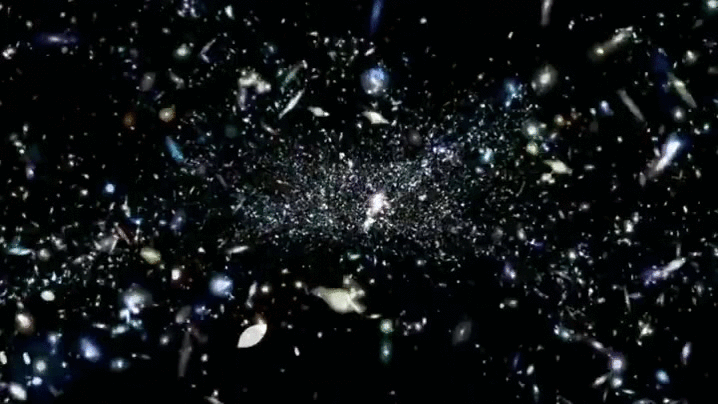Exploring the Enigmatic Cold Spot: Evidence of a Multiverse?
Written on
Chapter 1: The Birth of the Universe
The universe commenced with a cataclysmic explosion, its initial form a dense and fiery orange mass, with plasma bubbling at extreme temperatures. In this radiant expanse marking the dawn of existence, protons and electrons combined, creating a brilliant light vastly different from the dark sky we observe today. It took 380,000 years for the first atoms to coalesce in cooler conditions, leading to the formation of hydrogen and helium, the essential building blocks for stars—those luminous entities scattered across the universe, where elements like carbon, oxygen, and iron are forged. Reflecting on that tumultuous inception, we find ourselves in a much calmer and cooler cosmos. Yet, the energy from this chaotic period, just hundreds of thousands of years post-Big Bang, may indicate something even more remarkable.
The energy from this epoch is represented by the Cosmic Microwave Background (CMB). This radiation is remarkably uniform, typically fluctuating no more than 20 microkelvin across the mapped sky. Initially, when atoms formed, the temperature was around 3,000 Kelvin, but after 13 billion years of cosmic expansion, it has cooled to approximately 2.725 degrees above absolute zero (-454 degrees Fahrenheit or -270 Celsius). This expansion has also shifted the wavelengths of light from infrared to microwave, rendering outer space largely transparent and dark to our perception. However, an intriguing area of the CMB, known as the Cold Spot, exhibits a significant deviation from the norm, being 150 microkelvin cooler than average and spanning a distance of 1 billion light years. Both the WMAP (NASA’s Wilkinson Microwave Anisotropy Probe) and the Planck satellite have observed this anomaly, confirming it is not merely a result of measurement error.

Chapter 2: Theories Behind the Cold Spot
Until early 2017, one prominent explanation for the Cold Spot involved the concept of supervoids. While not entirely devoid of matter, voids in space contain significantly fewer galaxies than their denser counterparts. Surrounding these voids, galaxies cluster into massive formations known as superclusters—some of the largest structures in the universe. The Cold Spot might have emerged as CMB radiation traversed one of these supervoids, affected by the Integrated Sachs-Wolfe (ISW) effect. This effect describes how photons gain energy when passing through matter-dense regions and lose energy in less dense areas, leading to the appearance of cooler regions on the CMB.
The supervoid theory, proposed in 2006, gained traction after a 2015 study from the University of Hawaii claimed to have identified a 1.8 billion light-year void in the Cold Spot's direction. However, subsequent research has struggled to confirm these findings. A 2017 study by Durham University, involving a redshift survey of 7,000 galaxies in the Cold Spot's vicinity, found three large voids, potentially a fourth, but these voids would only account for a temperature drop of 32 microkelvin, far less than the 150 microkelvin observed.

Section 2.1: Alternative Explanations
So, if the Cold Spot isn't due to supervoids, what could be causing it? One possibility is sheer randomness. Simulations suggest that a feature like the Cold Spot might occur in about 1 out of every 50 universes, implying we could simply inhabit a unique universe. Research led by Mackenzi and Shanks estimates the odds of such a cold region at 1-2% based on our current cosmological model.
However, a more thrilling hypothesis remains on the table: the multiverse theory. This notion arises from the concept of inflation—an explosive expansion shortly after the Big Bang that offers an explanation for the universe's vastness and structure. Many inflation theories propose that the process is eternal, continuously creating bubbles of "normal" universes like ours that have stabilized. If our universe bubble collided with another during its early expansion, it could have left a mark on the CMB, manifesting as the Cold Spot. When such bubbles merge, they exchange energy, potentially creating either a cold or hot spot on the CMB map.
According to Professor Tom Shanks, “The craziest sounding of the exotic models of the explanation of the Cold Spot, the multiverse, is actually the most standard in terms of our current model of the universe.”

Chapter 3: Future Observations and Speculations
Critics of the multiverse theory argue that the universe's vastness diminishes the likelihood of another universe colliding with ours in an observable area of the sky. Additionally, human error could skew results due to the statistical algorithms employed in measuring CMB variations, potentially leading to misinterpretations. Ongoing observations and analyses, particularly those from the Planck satellite, are expected to either validate or challenge the hypotheses surrounding the Cold Spot.
For now, we find ourselves in a state of uncertainty, gazing at the cosmic radiation enveloping us and pondering the origins of that peculiar, elusive spot. Whether it is a sign of a multiverse or simply a statistical anomaly, it presents a riddle that challenges our cosmological understanding. While it raises more questions than answers, it simultaneously sparks our imagination, suggesting that perhaps we are not as isolated in this vast universe as we might have thought.
The Evidence of the Multiverse Is in Sight! - This video explores potential signs of the multiverse, delving into the mysteries of the Cold Spot and cosmic anomalies.
Is There Really No Evidence for the Multiverse? - This video examines the arguments for and against the existence of the multiverse, questioning the implications of the Cold Spot.